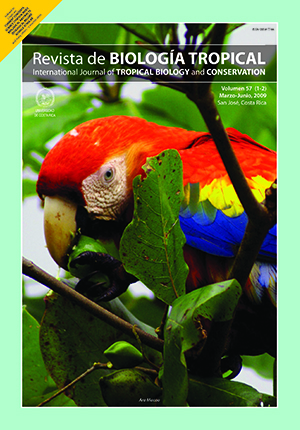Resumen
En la gran mayoría de las áreas legalmente protegidas en México, los habitantes locales utilizan los recursos naturales para leña o para la alimentación de animales. Estas perturbaciones frecuentes y de baja intensidad, impactan fuertemente la estructura y la capacidad de regeneración de los ecosistemas tropicales. A pesar de su importancia, la dinámica de la regeneración después de la exclusión de la perturbación, todavía es poco conocida. Evaluamos el impacto de doce años de exclusión (E) de la entrada del ganado y extracción de leña en la composición y dinámica de la lluvia de semillas al comparar con un área sin la exclusión de estas perturbaciones (SE). Se encontró una fuerte estacionalidad en la lluvia de semillas (96% de las semillas cayeron en la estación seca). No se encontraron diferencias significativas entre los sitios excluidos y no excluidos en relación a la densidad, riqueza de especies y diversidad de las semillas. Sin embargo, la distribución de estas semillas al largo del año, fue significativamente distinta entre los dos sitios. El índice de similitud entre los sitios (E y SE) fue relativamente bajo (0.57). La barocoria fue el modo de dispersión más común entre las 23 especies (48%), seguida por la anemocoria (39%) y la zoocoria (13%). En lo que se refiere a la densidad de semillas, la anemocoria fue el modo de dispersión más observado (88%). La mayoría de las especies tienen semillas pequeñas (92%) y no se encontraron diferencias en la distribución de semillas por clases de tamaño entre los sitios E y SE. La distribución espacial de las cuatro especies más importantes fue agregada. Aunque los 12 años de exclusión no fue- ron suficientes para restaurar completamente el potencial regenerativo de la zona, algunas diferencias ya empezaron a ser perceptibles. Casi no hay especies zoocoras en ambos sitios y la reintroducción de especies clímax y atractoras de animales podría ser un estrategia interesante, además de la exclusión de la perturbación, para acelerar la restauración ecológica.##plugins.facebook.comentarios##

Esta obra está bajo una licencia internacional Creative Commons Atribución 4.0.
Derechos de autor 2009 Revista de Biología Tropical
Descargas
Los datos de descargas todavía no están disponibles.






